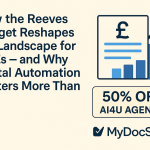AI vs. Security: How to Protect Your Sensitive Documents in the Age of Automated Analysis
Artificial intelligence is transforming how businesses manage information. From accelerating due-diligence reviews to automatically extracting data from contracts, AI promises speed, accuracy and a dramatic reduction in manual work.
But AI also brings a risk many organisations underestimate: AI analysis can undermine secure document storage if used incorrectly.
In an era where documents flow through multiple systems — some of them opaque, cloud-based and not always aligned with your compliance needs — it has never been more important to understand how to keep your information safe.
Below, we explore why AI introduces new security challenges, what you can do about them, and how MyDocSafe can support you in implementing AI responsibly.
🔐 The Hidden Risk: AI Analysis Can Kill Security
Most modern AI tools rely on submitting your documents to a third-party system. That means:
- Your files leave your secure environment.
- Data may be stored, cached, or used to improve models.
- Sensitive information becomes exposed to unknown access controls.
- You may violate regulatory or contractual obligations without realising it.
Even when an AI vendor says they “don’t train on your data”, the real question is:
Where do your documents actually go — and who can access them?
In regulated industries, this is critical. Client onboarding, tax records, legal contracts, HR files, and financial statements cannot simply be uploaded to any AI system without putting your compliance at risk.
This is why secure document storage and secure AI usage must be tightly integrated, not treated as separate workflows.
📁 Why Traditional ‘Secure Storage’ Isn’t Enough Anymore
Even if your documents sit inside a compliant repository (ISO 27001, GDPR-ready, encrypted at rest), the moment you:
- export them,
- email them,
- copy them into another system,
- ask an external AI to “read” them,
—you create a new exposure point.
Security today is no longer defined by where your documents live, but where they travel.
Which means the question businesses should ask is:
“How do we enable AI-driven workflows without breaking our secure document storage policies?”
🛡️ Three Approaches to AI That Keep Documents Secure
1. Local or Private AI Models (Bring AI to the Documents)
Instead of sending documents to AI, you bring AI into your secure environment.
Your files never leave your storage platform.
This avoids:
- data leaks
- unauthorised use
- jurisdictional risk
- unknown model training practices
This is the direction leading organisations are now taking — and it is rapidly becoming the gold standard.
2. Controlled AI Connectors
Some platforms (including MyDocSafe) integrate AI in a controlled, auditable way.
You decide:
- which documents the AI can access
- what questions it can answer
- who can see its output
- how data is stored or deleted
This lets teams use AI safely while keeping documents inside approved systems.
3. Anonymisation Before AI Processing
If documents must leave your secure environment, anonymisation becomes essential.
Automated anonymisation can:
- remove names,
- strip financial identifiers,
- mask client-sensitive details,
- preserve the structure and meaning of the file while eliminating personal data.
This allows AI to work on “safe” documents — drastically reducing compliance and privacy risk.
Anonymisation is far more than simple masking. Hiding names, numbers or email addresses is only the first step—but it does not guarantee privacy if the remaining context still points clearly to a specific person or company. True anonymisation requires removing or transforming any detail that could allow identity to be inferred, even indirectly: unusual job titles, rare combinations of attributes, financial patterns, timelines, locations, or deal structures. In other words, anonymisation must eliminate not just explicit identifiers, but implicit clues that make re-identification possible. Effective anonymisation therefore relies on context analysis, consistency rules, and in some cases synthetic substitution to ensure that sensitive data cannot be reconstructed. It is a discipline—not a cosmetic edit—and should be treated as part of a serious information-security strategy whenever documents are being prepared for AI processing.
🧩 How MyDocSafe Helps You Use AI Securely
We built MyDocSafe around a simple principle:
Documents should remain secure — even when AI is involved.
Here’s how we support this:
✅ Secure document storage with encryption at rest & in transit
Your files stay inside your organisation’s compliant environment.
✅ Client portals for controlled sharing
Granular access ensures only authorised parties see what they should.
✅ Private AI assistants inside portals
You can deploy AI safely without sending documents outside MyDocSafe. We work with Ai4U.digital to bring to you Korrah, an AI assistant you can train, rebrand and rename.
✅ Optional anonymisation workflows
Before any AI analysis occurs, we can help automatically anonymise document sets.
✅ Audit trails for all AI interactions
Every question, every access point, every output — recorded for compliance.
✅ Custom AI deployments
For organisations needing fully private models.
📣 Want AI Without Losing Security? Talk to Us.
If you want to use AI but don’t want to compromise your secure document storage, we can help you design a safe, compliant, fully auditable solution.
Whether you need:
- private AI inside secure portals
- anonymisation pipelines
- controlled AI access for clients
- workflow-integrated AI assistants
—our team can guide you.
Contact MyDocSafe to discuss your AI security requirements.
Write to us today:
sales@mydocsafe.com


